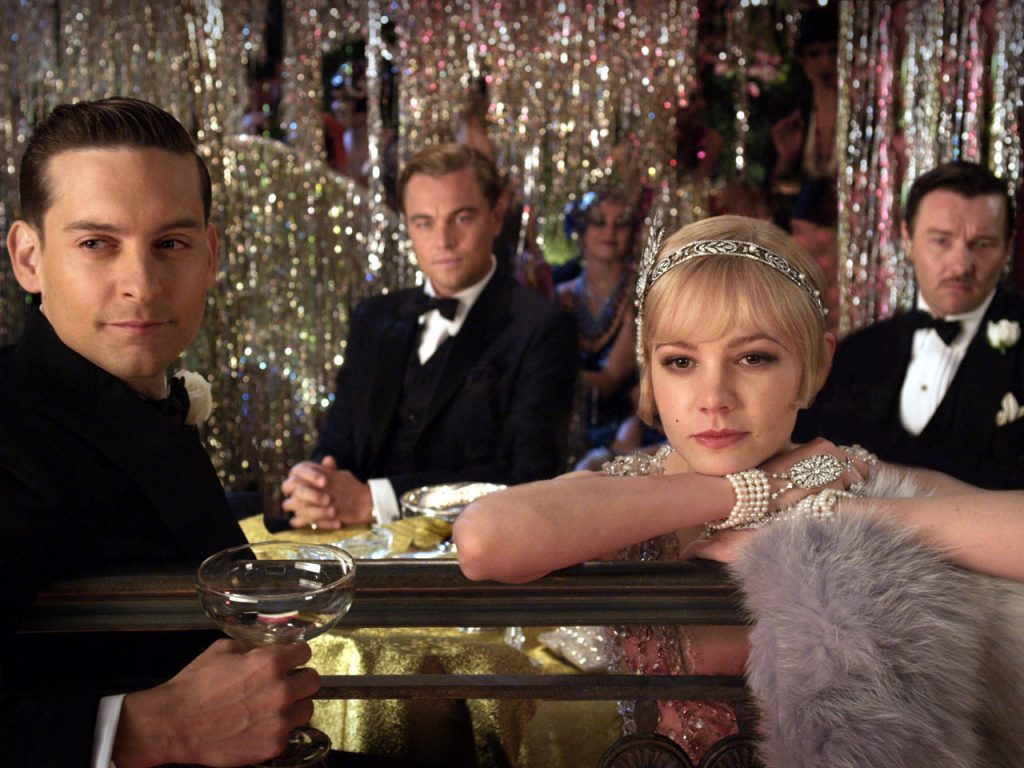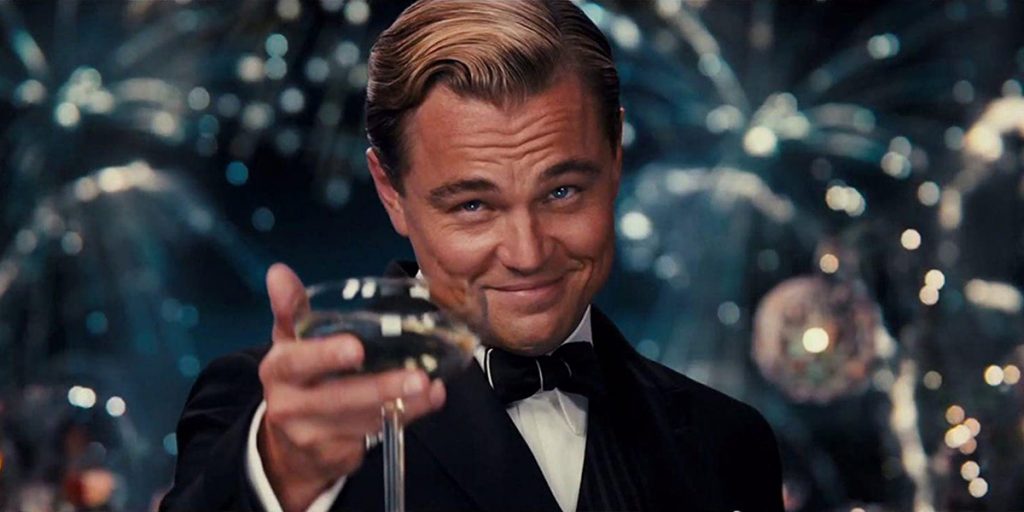The Great Gatsby is an appropriately over-the-top spectacle that matches the glamour of its source material while keeping its emotional moments intact.
If you attended a public school in the United States, chances are that, at some point, you were forced to read F. Scott Fitzgerald’s seminal classic The Great Gatsby. Fitzgerald’s novel was not a critical or financial success at the time of publication, and when he died, he believed his novel to be a failure. However, the novel was rediscovered during World War 2 where it was positively reassessed by critics and became the cultural phenomenon we know today. His story has embedded itself into the American subconscious and even inspired the best Lorde song, Green Light (no, this is not up for debate). Like all great works of literature, it was only a matter of time before the novel was translated to film.
At first glance, The Great Gatsby feels tailor made for the silver screen. The novel tells the story of self-mad millionaire Jay Gatsby (Leonardo DiCaprio) through the eyes of his friend Nick Carraway (Tobey Maguire) as he searches for, finds, and tragically loses his long-lost love Daisy Buchanan (Carey Mulligan), who has since married Tom (Joel Edgerton). Also present are Daisy’s friend Jordan Baker (Elizabeth Debicki), whom Nick has a short-lived relationship with, and the impoverished Wilson couple George (Jason Clarke) and Myrtle (Isla Fisher), with whom Tom is having an affair.
With its grand sets and enchanting dialogue, The Great Gatsby had all the ingredients to be a classic no matter what time period it was made in. However, an adaptation that truly captured the spirit and feeling of the novel proved elusive, with two adaptations in 1949 and 1974 missing the mark and falling into obscurity. Then in 2008, a new version was announced with Baz Luhrmann on board as director, and what resulted is one of the most polarizing films of the last decade.

Luhrmann’s history as a director, at that point, consisted of lavish musicals and period pieces (Moulin Rouge!, Strictly Ballroom, and Romeo + Juliet stand out as clear examples) that invested most of their production costs into intricate sets and jaw-dropping costumes. It made sense, then, for him to take on a story set at the height of the roaring twenties, a period heavily characterized by its excess. This is especially true as the first half of the book has multiple scenes set at large parties hosted by the titular character. It is in these scenes that Luhrmann’s talents shine: the frame is constantly filled with people, food, decorations, and a general lack of space as our protagonist Nick, an aspiring bond salesman and impartial observer who serves as the films moral compass, attempts to locate Mr. Gatsby. You can see the time taken to create such an environment that closely resembles the language of the book. Luhrmann can simultaneously convey Nick’s alienation and the sheer mass of bodies in the same shoot.
Luhrmann stumbles, however, when he is tasked with recreating iconic images present in the novel. His previous films such as Moulin Rouge! are all extremely kinetic, with both the camera and characters always moving, creating a frame that is always shifting and keeping you engaged. Early in the film and the book, Nick observes Gatsby late at night, reaching his hand out towards a green light that is later revealed to be located at the end of the dock belonging to his former lover, Daisy Buchanan.
The light has been thought to mean many things, including the American Dream, Gatsby’s past, and his ultimate goal of Daisy. In the novel, the focus of the moment is on Gatsby and his yearning for Daisy (though this is unknown to the audience, at this point): Gatsby’s hand is even said to tremble as he is overcome with emotion. Luhrmann, determined to save the surprise of DiCaprio’s casting for later, keeps his face hidden and glides past Gatsby’s back and transitions into a CGI shot that glides over the lake to the light, instead letting Nick narrate Gatsby’s expressions.
This pops up again when Nick and Gatsby formally meet for the first time at one of Gatsby’s parties: the novel presents this with little pomp and circumstance, with Nick and Gatsby casually bumping into each other by chance. Luhrmann turns the moment into a grandiose occasion, no doubt in part due to DiCaprio’s casting. While this isn’t bad per se, it’s almost contradictory to how Fitzgerald presented it in the novel and betrays the spirit of what he intended, something that Luhrmann takes careful care not to do in the rest of the film. Thankfully, these moments appear in the first act of the film and all but disappear as the film progresses, allowing The Great Gatsby to come into its own as a film.
Surprisingly, Luhrmann’s script, which was co-written with his Moulin Rouge! and Romeo + Juliet collaborator Craig Pierce, accurately captures the nuance present in the book and puts a new spin on it. Luhrmann commented that he wanted to write a script that was more critical of the lifestyle of the rich characters, as the original novel is surprisingly light on harsh judgments, with the notable exception of Tom and Daisy towards the conclusion. Famously, The Great Gatsby is awfully forgiving of its titular character, who exhibits all the characteristics of what we would call a simp today. Despite nearly destroying a marriage and causing great emotional distress to his former lover, Nick continues to excuse Gatsby’s actions throughout, citing his endless capacity for hope and impoverished past as excuses for his actions.
While the film certainly keeps the surface text in the form of narration, the filmmaking techniques exhibited paint a much less flattering picture of Jay. Namely, this happens in the hotel scene at the end of the second act, where Gatsby becomes possessive towards Daisy and violent towards Tom after attempting to break up their marriage, shattering his carefully constructed façade to reveal a much darker interior. At this moment, the scene nearly comes to a halt, in full close-up of Gatsby’s enraged face, forcing the audience to fully consider the morality of his actions.
Perhaps the aspect that gets the least recognition and is the most deserving of attention is the impeccable casting of all main and supporting characters. Fitzgerald created an unforgettable cast of characters in Jay, Nick, Daisy, Tom, Jordan, Myrtle, and George, and each cast member perfectly embodies the essence of their character. DiCaprio’s status as one of the most popular stars of the last twenty years, along with his reliably magnetic screen presence, lets him fill the scene in his most iconic moments, while Maguire perfectly fills Nick’s role as an observer and moral compass. Carey Mulligan and Joel Edgerton nail the Buchanan’s terse dynamic of an unhappy couple barely holding on to a crumbling illusion of happiness.
Even though Ilsa Fisher and Jason Clarke have less screen time than the four mentioned above, each deftly translates their character’s novel personas into believable people that you could come across on the street. This also served as Elizabeth Debicki’s breakout role as Jordan Baker, in what continues to be one of the great underrated roles of the decade, crafting a performance that makes us love her one moment and despise her the next. Without these actors in these roles, the film wouldn’t come together and would result in a hollow picture and a half-baked adaptation.
Despite the numerous positive aspects of the film from the casting and performances to the added nuance to the screenplay to the exceptional production values, The Great Gatsby contains some baffling artistic choices. The decision to fill the soundtrack with modern pop and hip hop is as confusing today as it was in 2013, no matter how good Lana Del Ray’s Young and Beautiful is, which was the original song produced for the film and is featured in many key scenes. The film is extraordinarily dedicated to creating a pristine version of the roaring twenties through its sets and costumes, but the illusion is ruined as soon as Jay-Z or Beyonce’s voices enter the frame.
Music in the twenties was known for its upbeat and sensual jazz numbers that gave rise to dances such as the jitterbug and tango, which are very energetic in nature. So why not fill the soundtrack with songs that were popular at the time and would have had the same energy? The decision takes viewers out of the experience of the film, and seems made only to have a soundtrack to sell for additional profits.
With as many great decisions as there are questionable ones, The Great Gatsby works more as a simple good time at the movies than an artistic masterpiece of film. Perhaps the source material is simply too good to completely fail when put in the hands of a capable team, or the glitz and glam ultimately wins you over when exposed for long enough. In the end, Luhrmann’s adaptation is faithful the themes and style of the novel while his extraordinary cast gives life to an iconic story. It was undeserving of the hate it received upon its release and is long overdue for a reevaluation from critics and cinephiles alike, just like the novel did.
WATCH THE GREAT GATSBY:
Loud and Clear Reviews has an affiliate partnership with Apple, so we receive a share of the revenue from your purchase or streaming of the films when you click on the button on this page. This won’t affect how much you pay for them and helps us keep the site free for everyone.

